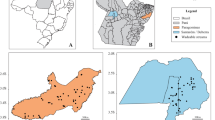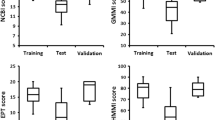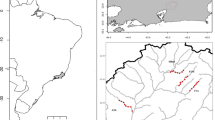Abstract
The construction of biotic indices that use macroinvertebratesto assess pollution and other anthropogenic disturbances ofrivers and streams often requires that each taxon be assigned anumber indicating its level of sensitivity. A problem inconstructing such indices is that individual taxa may varyquite widely in sensivity, depending on the nature of theparticular disturbance. One possible means of overcoming thisproblem is to construct a suite of indices, each assembledusing sensitivity numbers targeted to a particular impact.
In order to test this idea, we sampled macroinvertebrates fromrivers in south-eastern Australia subjected to three differenttypes of anthropogenic disturbance: operation of large dams,discharge of effluent from municipal sewage treatment plants,and contamination by metals originating from historical mining.Using macroinvertebrate data from sampling sites with varyinglevels of exposure to disturbance, we developed sensitivitynumbers for macroinvertebrate families for individual riversand combinations of rivers with the same disturbance type.
Sensitivity numbers calculated for individual families differedsignificantly according to disturbance type in several cases.Gastropod molluscs (family Thiaridae) were tolerant of dameffects but sensitive to sewage and metals, whereascoenagrionid damselfly nymphs, elmid beetles and ostracods weremost tolerant of sewage. Corydalid alderfly larvae,leptophlebiid mayfly nymphs, lestid damselfly nymphs,libellulid dragonfly nymphs and scirtid beetle larvae weremost tolerant of metals. Indices constructed using sensitivitynumbers for a particular disturbance were generally mostresponsive to that disturbance, but there was considerablegenerality in responses as well as substantial variabilitybetween different rivers with the same disturbance type. Inparticular, macroinvertebrate communities at sites downstreamof dams responded quite variably, probably because ofsubstantial differences in release regimes. We conclude thatthe approach has merit but requires considerable furtherdevelopment and testing, as well as consideration of the levelsof specificity and diagnostic strength that are appropriate orachievable.
Similar content being viewed by others
References
Armitage, P. D., R. J. M. Gunn, M. T. Furse, J. F. Wright & D. Moss, 1987. The use of prediction to assess macroinvertebrate response to river regulation. Hydrobiologia 144: 25–32.
Armitage, P. D., D. Moss, J. F. Wright & M. T. Furse, 1983. The performance of a new biological water quality score system based on macroinvertebrates over a wide range of unpolluted running water sites. Wat. Res. 17: 333–347.
Arthington, A. H., D. L. Conrick, D. W. Connell & P. M. Outridge, 1982. The ecology of a polluted urban creek. Australian Water Resources Council Technical Paper No. 68. Australian Government Publishing Service, Canberra.
Barton, D. R. & J. L. Metcalfe-Smith, 1992. A comparison of sampling techniques and summary indices for assessment of water quality in the Yamaska River, Québec, based on benthic macroinvertebrates. Envir. Monit. Assess. 21: 225–244.
Blühdorn, D. & A. Arthington, 1994. The effects of flow regulation in the Barker–Barambah catchment. Centre for Catchment and In-stream Research, Griffith University, Brisbane.
Boyd, M., 1993.Water quality and ecology of the Nattai River. Australian Water Technologies Science and Environment, Sydney, report No. 93/13.
Camargo, J. A., 1993. Macrobenthic surveys as a a valuable tool for assessing freshwater quality in the Iberian Peninsula. Envir. Monit. Assess. 24: 71–90.
Campbell, I. C., 1978. A biological investigation of an organically polluted urban stream in Victoria. Aust. J. mar. Freshwat. Res. 29: 275–291.
Cao, Y., A.W. Bark & W. P. Williams, 1996. Measuring the responses of macroinvertebrate communities to water pollution: a comparison of multivariate approaches, biotic and diversity indices. Hydrobiologia 341: 1–19.
Cao, Y., A. W. Bark & W. P. Williams, 1997. Analysing benthic macroinvertebrate community changes along a pollution gradient: a framework for the development of biotic indices. Wat. Res. 31: 884–892.
Castella, E., M. Bickerton, P. D. Armitage & G. E. Petts, 1995. The effects of water abstractions on invertebrate communities in U.K. streams. Hydrobiologia 308: 167–182.
Chapman, B. M., D. R. Jones & R. F. Jung, 1983. Processes controlling metal ion attenuation in acid mine drainage streams. Geochim. Cosmochim. Acta 47: 1957–1973.
Chapman, P. M., M.A. Farrel & R. O. Brinkhurst, 1982. Relative tolerances of selected aquatic oligochaetes to individual pollutants and environmental factors. Aquat. Toxicol. 2: 47–67.
Chessman, B.C., 1995. Rapid assessment of rivers usingmacroinvertebrates: a procedure based on habitat-specific sampling, family-level identification and a biotic index. Aust. J. Ecol. 20: 122–129.
Chessman, B. C. & D. P. Robinson, 1987. Some effects of the 1982–83 drought on water quality and macroinvertebrate fauna in the lower La Trobe River, Victoria. Aust. J. Mar. Freshwat. Res. 38: 289–299.
Chessman, B. C., J. E. Growns & A. R. Kotlash, 1997. Objective derivation of macroinvertebrate family sensitivity grade numbers for the SIGNAL biotic index: application to the Hunter River System, New South Wales. Mar. Freshwat. Res. 48: 159–172.
Chutter, M., 1994. The rapid biological assessment of stream and river water quality bymeans of the macroinvertebrate community in South Africa. In M. C. Uys (ed.), Classification of Rivers and Environmental Health Indicators. Proceedings of a Joint South African/Australian Workshop, February 7–14 1994, Cape Town, South Africa. Water Research Commission Report No. TT63/94.
Cosser, P. R., 1988. Macroinvertebrate community structure and chemistry of an organically polluted creek in south-east Queensland. Aust. J. mar Freshwat. Res. 39: 671–683.
Dames & Moore Pty Ltd, 1993. Captains Flat mine site–assessment of options for further remediation for N.S.W. Environment Protection Authority–final report.
Davies, P. E., N. J. Mitchell & L. A. Barmusta, 1996. Mount Lyell revisited: acid mine drainage, macroinvertebrates and RIVPACS in the Queen and King river catchments. Australian Society for Limnology Inc. 35th Congress Abstracts and Programme, 48.
De Shon, J. E., 1995. Development and application of the Invertebrate Community Index (ICI). In W. S. Davis & T. P. Simon (eds), Biological Assessment and Criteria. Tools for Water Resource Planning and Decision Making. Lewis, Boca Raton: 217–243.
Doeg, T. J., G. W. Davey & J. D. Blyth, 1987. Response of the aquatic macroinvertebrate communities to dam construction on the Thomson River, southeastern Australia. Reg. Rivers. Res. & Mgmt. 1: 195–209.
Ewell, W. S., J. W. Gorsuch, R. O. Kringle, K. A. Robillard & R. C. Spiegel, 1986. Simultaneous evaluation of the acute effects of chemicals on seven aquatic species. Envir. Tox. Chem. 5: 831–840.
Gippel, C. J. & M. J. Stewardson, 1995. Development of an environmental flow management strategy for the Thomson River, Victoria, Australia. Reg. Rivers. Res. & Mgmt. 10: 121–135.
Growns, J. E., B. C. Chessman, J. E. Jackson & D. G. Ross, 1997. Rapid assessment of Australian rivers using macroinvertebrates: cost and efficiency of six methods of sample processing. J. North am. Benth. Soc. 16: 682–693.
Growns, J. E., B. C. Chessman, P. K. McEvoy & I. A. Wright, 1995. Rapid assessment of rivers using macroinvertebrates: case studies in the Nepean River and Blue Mountains, NSW. Aust. J. Ecol. 20: 130–141.
Hannaford, M. J. & V. H. Resh, 1995. Variability in macroinvertebrate rapid-bioassessment surveys and habitat assessments in a northern California stream. J. North am. Benth. Soc. 14: 430–439.
Hawkes, H. A., 1962. Biological aspects of river pollution. In L. Klein (ed.), River Pollution II. Causes and Effects. Butterworths, London: 311–432.
Hill, M. O., 1973. Reciprocal averaging: an eigenvector method of ordination. J. Ecol. 61: 237–249.
Hilsenhoff, W. L., 1987. An improved biotic index of organic stream pollution. Great Lakes Ent. 20: 31–39.
Hilsenhoff, W. L., 1988. Rapid field assessment of organic pollution with a family-level biotic index. J. North am. Benth. Soc. 7: 65–68.
Hogg, I. D. & R. H. Norris, 1991. Effects of runoff from land clearing and urban development on the distribution and abundance of macroinvertebrates in pool areas of a river. Aust. J.mar. Freshwat. Res. 42: 507–518.
Jones, J. R., B. H. Tracy, J. L. Sebaugh, D. H. Hazelwood & M. M. Smart, 1981. Biotic index tested for ability to assess water quality of Missouri Ozark streams. Trans. am. Fish. Soc. 110: 627–637.
Lake, P. S., D. Coleman, B. Mills & R. Norris, 1977. A reconnaissance of pollution of the King River in the Comstock-Crotty area, west Tasmania. In M. R. Banks & T. B. Kirkpatrick (eds), Landscape and Man. Royal Society of Tasmania, Hobart: 157–173.
Lenat, D. R., 1993. A biotic index for the southeastern United States: derivation and list of tolerance values, with criteria for assigning water-quality ratings. J. North am. Benth. Soc. 12: 279–290.
Mackey, A. P., 1988. The biota of the River Dee (CentralQueensland, Australia) in relation to the effects of acid mine drainage. Proc. r. Soc. Qld. 99: 9–19.
Marchant R., P. Mitchell & R. Norris, 1984. Distribution of benthic invertebrates along a disturbed section of the La Trobe River, Victoria: an analysis based on numerical classification. Aust. J. mar Freshwat. Res. 35: 355–374.
Marchant, R., 1989. Changes in the benthic macroinvertebrate community of the Thomson River after dam construction. Reg. Rivers. Res. & Mgmt. 4: 71–89.
McIvor, C. C., 1976. The effect of organic and nutrient enrichment on the benthic macroinvertebrate community of Moggill Creek, Queensland. Water 3: 16–21.
Napier, G. M., 1992. Application of laboratory-derived data to natural aquatic ecosystems. PhD thesis, Macquarie University.
Nicholas, W. L. & M. Thomas, 1978. Biological release and recycling of toxic metals from lake and river sediments. Australian Water Resources Council Technical Paper No. 33. Australian Government Publishing Service, Canberra.
Norris, R. H. 1986. Mine waste pollution of the Molonglo River, New South Wales and the Australian Capital Territory: effectiveness of remedial works at Captains Flat mining area. Aust. J. mar. Freshwat. Res. 37: 147–157.
Norris, R. H., P. S. Lake & R. Swain, 1982. Ecological effects of mine effluents on the South Esk River, north-eastern Tasmania III. Benthic macroinvertebrates. Aust. J. mar. Freshwat. Res. 33: 789–809.
Pearson R. G. & L. K. Penridge, 1987. The effects of pollution by organic sugar mill effluent on the macro-invertebrates of a stream in tropical Queensland, Australia. J. Envir. Mgmt. 24: 205–215.
Phillips, N. & G. Moller, 1995. An ecological and physical assessment of the condition of streams in the upper Condamine River catchment. Department of Primary Industries, Queensland.
Pinder, L. C. V. & I. S. Farr, 1987a. Biological surveillance of water quality–2. Temporal and spatial variation in the macroinvertebrate fauna of the River Frome, A Dorset chalk stream. Arch. Hydrobiol. 109: 321–331.
Pinder, L. C. V. & I. S. Farr, 1987b. Biological surveillance of water quality–3. The influence of organic enrichment on the macroinvertebrate fauna of small chalk streams. Arch. Hydrobiol. 109: 619–637.
Resh, V. H. & J. K. Jackson, 1993. Rapid assessment approaches to biomonitoring using benthic macroinvertebrates. In D.M. Rosenberg & V. H. Resh (eds), Freshwater Biomonitoring and Benthic Macroinvertebrates. Chapman & Hall, New York: 195–233.
Resh, V. H. & J. D. Unzicker, 1975. Water quality monitoring and aquatic organisms: the importance of species identification. J. Wat. Pollut. Cont. Fed. 47: 9–19.
Ross, D., N. Maini & H. Cross, 1996. Environmental flow guidelines and recommendations for the enlarged Pindari Dam–draft report. Department of Land and Water Conservation, Sydney.
Slooff, W., 1983. Benthic macroinvertebrates and water quality assessment: some toxicological considerations. Aquat. Toxicol. 4: 73–82.
Stark, J. D., 1985. A macroinvertebrate community index of water quality for stony streams. Water & Soil Misc. Publ. 87: 1–53.
Stark, J. D., 1993. Performance of the Macroinvertebrate Community Index: effects of sampling method, sample replication, water depth, current velocity, and substratum on index values. N. Z. J. mar. Freshwat. Res. 27: 463–478.
Walley, W. J. & H. A. Hawkes, 1996. A computer-based reappraisal of the Biological Monitoring Working Party scores using data from the 1990 river quality survey of England and Wales. Wat. Res. 30: 2086–2094.
Walley, W. J. & H. A. Hawkes, 1997. A computer-based development of the Biological Monitoring Working Party score system incorporating abundance rating, site type and indicator value. Wat. Res. 31: 201–210.
Watson, J. A. L., A. H. Arthington & D. L. Conrick, 1982. Effect of sewage effluent on dragonflies (Odonata) of Bulimba Creek, Brisbane. Aust. J. mar. Freshwat. Res. 33: 517–528.
Weatherly, A. H., J. R. Beevers & P. S. Lake, 1967. The ecology of a zinc-polluted river. In A. H. Weatherly (ed.), Australian Inland Waters and their Fauna. Australian National University Press, Canberra: 252–278.
Yoder, C. O. & E. T. Rankin, 1995. Biological response signatures and the area of degradation value: new tools for interpreting multimetric data. In W. S. Davis & T. P. Simon (eds), Biological Assessment and Criteria. Tools for Water Resource Planning and Decision Making. Lewis, Boca Raton: 263–286.
Author information
Authors and Affiliations
Rights and permissions
About this article
Cite this article
Chessman, B.C., McEvoy, P.K. Towards diagnostic biotic indices for river macroinvertebrates. Hydrobiologia 364, 169–182 (1997). https://doi.org/10.1023/A:1003142819625
Issue Date:
DOI: https://doi.org/10.1023/A:1003142819625




